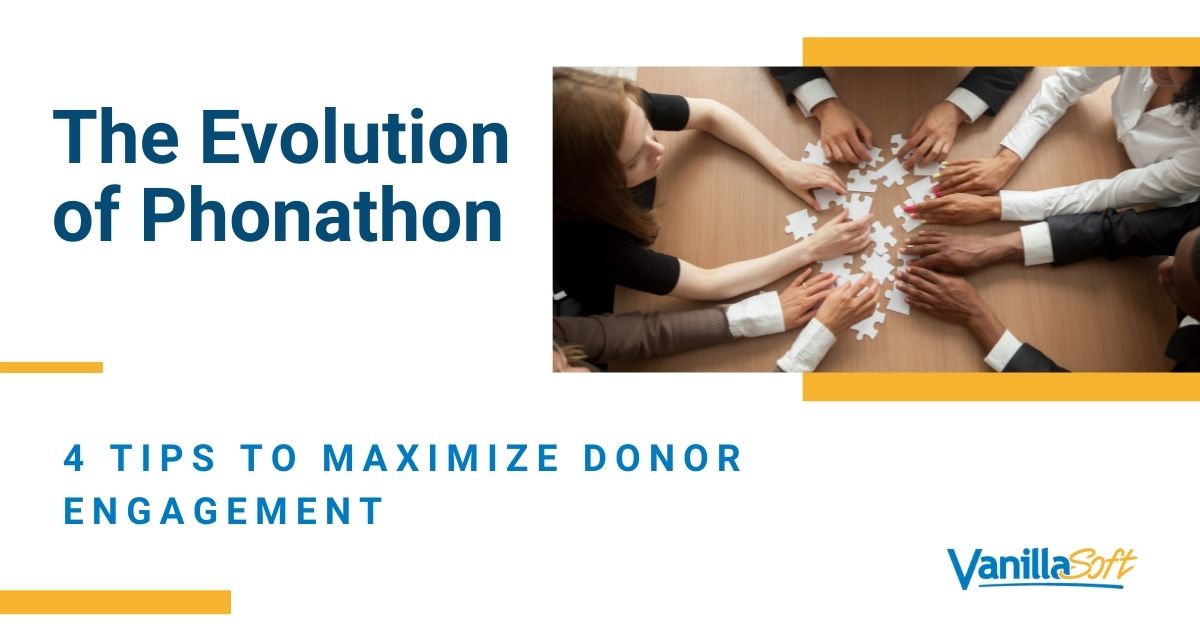
“Hi Mark! My name is John and I’m a first-year at XYZ University. I’m reaching out to share the latest campus updates and discuss the University Fund if that’s OK with you.”
The phonathon played a central role in higher ed fundraising for decades and universities managed to rake in millions of dollars with the help of the simple above messaging.
But, times have changed, and our hyper-personalized world demands universities to keep on raising the bar when it comes to (tele)fundraising campaigns. Alumni and other donors aren’t impressed by the smash-and-grab approach, which should now be a relic of the past.
Generic, mass outreach no longer works in the same way, that’s for sure.
But does that mean that the phonathon is obsolete or even dead?
Absolutely not. It simply evolved, so you have to adapt and regroup if you want your efforts to be successful.
Here are some tips to help you keep up with the Phonathon 2.0 revolution.
Go Multichannel

One hindrance to the traditional phonathon concept lies in the fact that it’s a single-channel strategy.
Student callers reach out to alumni, friends, and family of the institution and ask them to donate to your university. In many ways, phonathon outreach is similar to making cold calls in sales. Phone sales strategies had to evolve with customers, and your phonathon efforts need to expand to fit your donors’ needs.
Calling your prospects out of the blue and expecting them to say yes right away won’t happen frequently.
Instead, work on integrating SMS, social media, personalized video, and emails into your campaigns. This will make sure not only that you’re seen by your alumni, but also that you communicate with them in the way they want to be communicated with.
Here are some multichannel tactics to help improve your phonathon contact rates…
- Give them a heads-up
Let your donors know about your upcoming campaign.
For example, send them a pre-call postcard, email, or run a targeted Facebook ad. They will then be at least acutely aware you might be calling and more likely to pick up.
It’s a good idea to try and schedule a call in advance to prevent the old “this isn’t a good time” objection.
- Take donors’ preferences into consideration
If you notice that some donors only respond to emails or texts, don’t spend too much time trying to call them.
The odds are they won’t pick up, and you’ll only come off as annoying.
Keep records of your prospects’ preferences so that you can plan your future outreach. By targeting phone-friendly donors with a phone call, you can significantly boost your contact and pledge rates.
When it comes to new prospects you don’t have any historical data on, try identifying characteristics they share with your existing donors and segment this group accordingly.
- Keep your data clean
Let’s face it…landline phones are becoming extinct. It’s crucial to obtain your donors’ cell phone numbers and email addresses and keep your list up to date.
Data decays at a rate of 30% annually, so to prevent bad data from getting in the way of your fundraising campaigns, get rid of inaccurate contact information regularly.
- Refresh your lists regularly
While being persistent is essential, don’t become a pest. In other words, letting your lists rest is equally important.
Don’t call the same donors over and over again if you see that they don’t answer. Instead, switch to another group of fresh donors.
After a couple of weeks, you can put the previous segment back into the calling pool again.
- Leverage video messaging
No multichannel strategy is complete without personalized video. It goes particularly well with an email & phone campaign because it puts a face to a name.
People prefer watching videos to reading, but that’s not the only reason this channel will boost your engagement rates. It’s great in conveying emotion through body language, tone of voice, and other audio-visual cues.
And given that emotional communication is the key to connecting with your donors on a more personal level, video is a powerful medium that allows you to reach even those donors who don’t respond to your calls. You’ll be able to deliver a meaningful message as if you were in the same room.
Turn Your Call Center into a Digital Engagement Center
The main purpose of traditional phonathons was to solicit as many donations as possible using mass outreach, a little conversation, and even with less of a focus on true relationship fostering with alumni.
In an attempt to be efficient and resource-savvy, old-school phonathons targeted a large audience of donors using the “quantity over quality” approach.
However, Digital Engagement Centers (DECs) have rightfully evolved to reflect how we respond to and create relationships with our alumni.
And this next level of communication encompasses all the channels we discussed in the previous section and combines them into a strategically driven approach.
What are the benefits of a Digital Engagement Center?
- Creates a donor-centric focus to improve ROI

Donors are no longer regarded simply as one-off givers – they’re essential partners, and their experience matters most.
A DEC provides you with powerful predictive analytics together with a suite of different features that make it possible to target the right donor at the right time and using the right channel.
Incorporating a donor engagement solution is the perfect way to switch the focus to your alumni without a lot of additional work by your student callers. The right tool will allow you to automate your process while keeping a personal touch.
The features you should look for in a donor engagement solution:
- Customization of the user interface, campaign flow, and follow-up process
- Logical branch scripting, which will allow you to have natural conversations with alumni while getting your message across
- Personalized on-brand texts and email messages based on the outcome of the call make it easy to build meaningful relationships with donors and foster stewardship
- Updating donor information and details easily thus enriching your database and facilitating access to relevant data during caller interactions
- Dynamic call prioritization ensures that your team is always calling the next best available donor
- Different VoIP options and features to pick the best way to get in touch with your prospects and dial with one click
- Live Dashboard and custom reports.to help you monitor your progress
- Makes the most of your resources
A Digital Engagement Center is a game-changing synergy of technologies, channels, and techniques.
All these elements are often disconnected and ineffective in securing consistent and substantial donations. Bringing together all these elements and creating exceptional donor and student connections will yield a more significant ROI.
- Allows for working remotely
It’s impossible not to mention the COVID situation that resulted in a huge shift we refer to as the new normal – working from home.
Luckily, a DEC doesn’t have to be in a physical location, and your team can continue engaging donors from the comfort of their homes. Everything nowadays can happen remotely, so having the right tools to help you monitor your progress and campaign results is critical.
Involve Alumni with Your University Beyond Asking for Donations
As previously mentioned, fundraising and phonathons have similarities with sales and cold calling; let’s continue with the analogy.
Did you know that in the sales world it’s somewhere between 5 and 25 times more expensive to acquire a new customer than to sell to an existing one?
In sales, especially when making cold calls, it’s all about building loyalty, trust, and fostering deeper relationships with customers. And if customers are happy with doing business with a company, they are more likely to purchase from it again.
Carrying this framework over to fundraising – according to a study, 47% of donors repeat givers the following year. And latest surveys show that half of the donors planned to give in 2021 as much as they did in 2020.
Retention matters a lot, and it should be among your top priorities.
However, to achieve these numbers and establish a steady stream of donations, you need to involve alumni with your university to a greater extent. It’s not enough to get in touch with them once a year only to ask them to contribute.
It’s crucial to keep them in the loop about what is going on regularly – send them newsletters, invite them to different events, ask them to give tips to a new generation of students, and engage them on social media.
Their support doesn’t only have to be financial, as many of them are accomplished professionals whose feedback regarding your programs, new initiatives, and campaigns could be valuable on several levels. By taking this approach, you’ll get a lot of useful advice, and you’ll recruit them as your aides. They will be much more willing to help you if they’re, in a way, involved in the life on campus.
Finally, they can also give you a hand when onboarding new donors or even attracting new ones.
Engaging them with these different techniques can become a lifelong engagement where both parties benefit.
Motivate Your Team
When talking about the evolution of phonathon, it’s inevitable to mention those who grind most for the cause – student callers.
Their role has changed too, and they are now seen as Student Ambassadors, Student Gift Officers, or Digital Engagement Officers. These titles reflect the shift that took place in the entire process as they’re no longer simply students wanting to earn a bit of pocket money but rather as young professionals looking to learn, hone and improve their people and life skills, preparing them for life beyond university. Some schools even give accreditations to their student callers that will benefit them when it comes to applying for jobs in specific sectors.
A Student Ambassador role isn’t a temporary gig that will pay for minor expenses while living on campus. It’s a stepping stone that can land these young people many business opportunities in the future and serve as an excellent experience for their professional life.
Do You Know How to Keep Up With the Evolution of Phonathon?
You must shift from a single-channel tactic focused on soliciting donations to a more sophisticated and subtle multichannel approach that creates relationships. A well-structured strategy and the right technology will help you transform your process and create a Digital Engagement Center that facilitates communication with your alumni and encourages donations.



